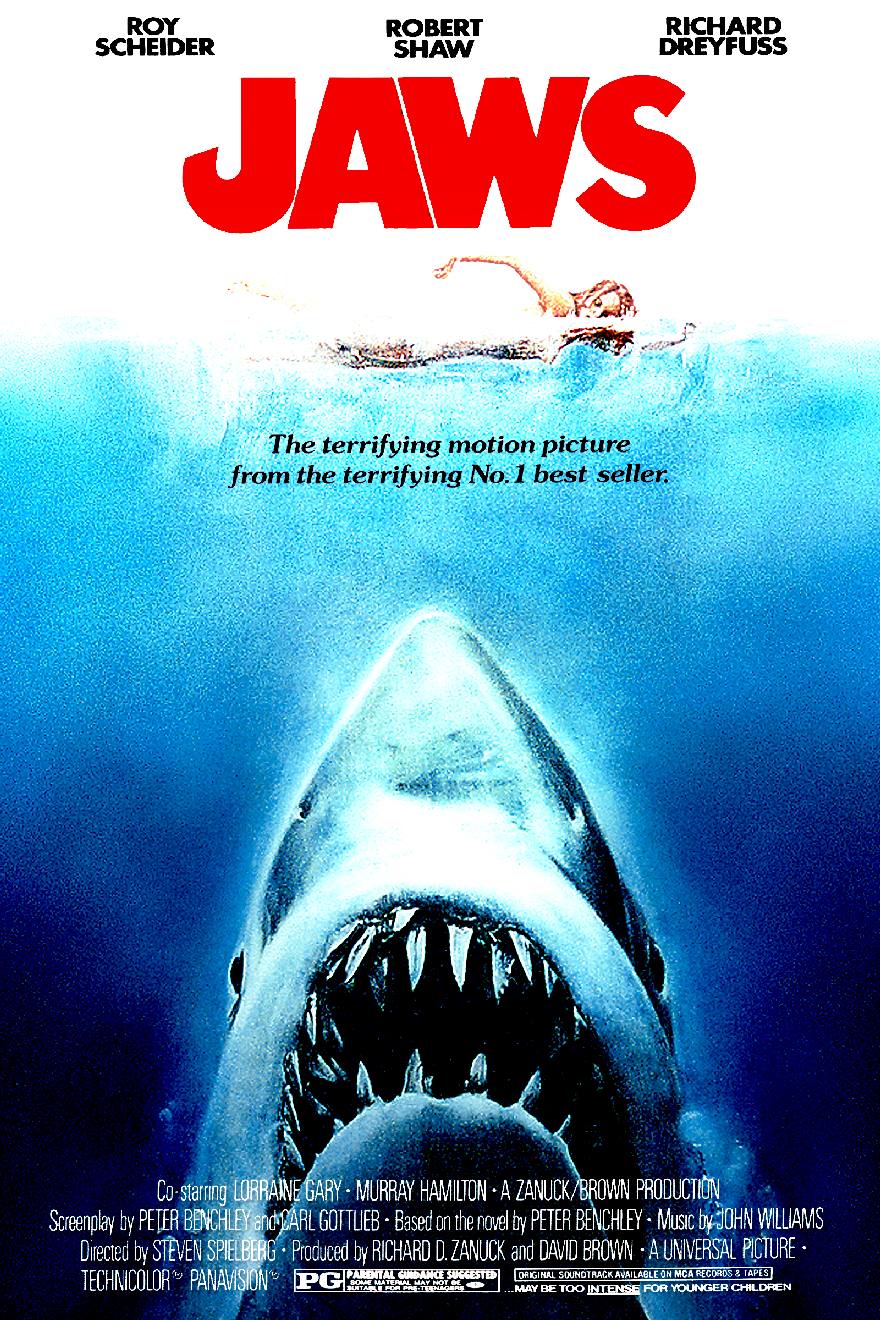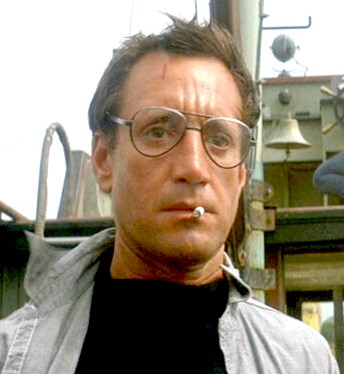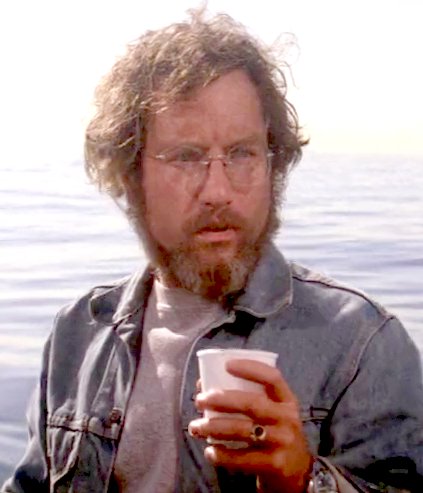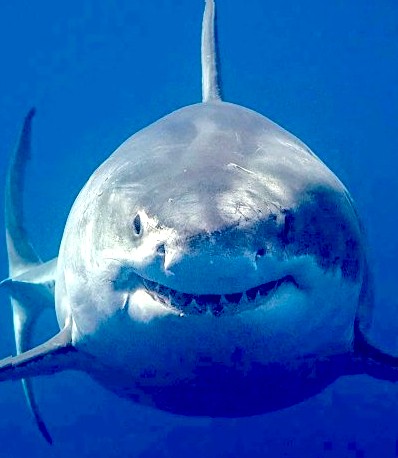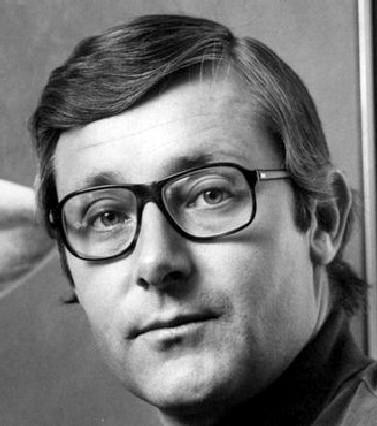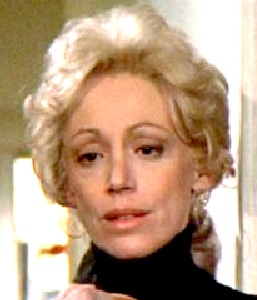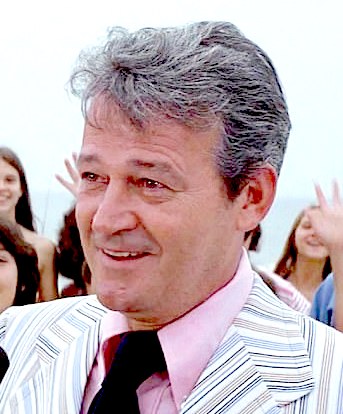DEVELOPMENT
Richard D. Zanuck and David Brown were both producers at Universal Pictures.
They independently heard about Peter
Benchley's novel Jaws. Brown came across it in the literature section of lifestyle magazine Cosmopolitan, then edited by his wife, Helen Gurley Brown. A small card written by the magazine's book editor gave a detailed description of the plot, concluding with the comment "might make a good movie". The producers each read the book over the course of a single night and agreed the next morning that it was "the most exciting thing that they had ever read" and that they wanted to produce a film version, although they were unsure how it would be accomplished. They purchased the film rights in 1973, before the book's publication, for approximately $175,000 (equivalent to $990,000 in 2018). Brown claimed that had they read the book twice, they would never have made the film because they would have realized how difficult it would be to execute certain sequences.
To direct, Zanuck and Brown first considered veteran filmmaker John Sturges
- whose résumé included another maritime adventure, The Old Man and the
Sea - before offering the job to Dick Richards, whose directorial debut, The Culpepper Cattle Co. had come out the previous year. They soon grew irritated by Richards's habit of describing the shark as a
whale and dropped him from the project. Meanwhile,
Steven Spielberg very much wanted the job. The 26-year-old had just directed his first theatrical film, The Sugarland Express, for Zanuck and Brown.
At the end of a meeting in their office, Spielberg noticed their copy of the still-unpublished Benchley novel, and after reading it was immediately captivated. He later observed that it was similar to his 1971 television film Duel in that both deal with "these leviathans targeting everymen". He also revealed in "The Making of Jaws" documentary on the 2012 DVD release that he directly referenced Duel by
re-purposing the sound of the truck being destroyed as the death roar of the shark. After Richards's departure, the producers signed Spielberg to direct in June 1973, before the release of The Sugarland Express.
Before production began, Spielberg grew reluctant to continue with Jaws, in fear of becoming typecast as the "truck and shark director". He wanted to move over to 20th Century Fox's Lucky Lady instead, but Universal exercised its right under its contract with the director to veto his departure. Brown helped convince Spielberg to stick with the project, saying that "after
[Jaws], you can make all the films you want". The film was given an estimated budget of $3.5 million and a shooting schedule of 55 days. Principal photography was set to begin in May 1974. Universal wanted the shoot to finish by the end of June, when the major studios' contract with the Screen Actors Guild was due to expire, to avoid any disruptions due to a potential strike.
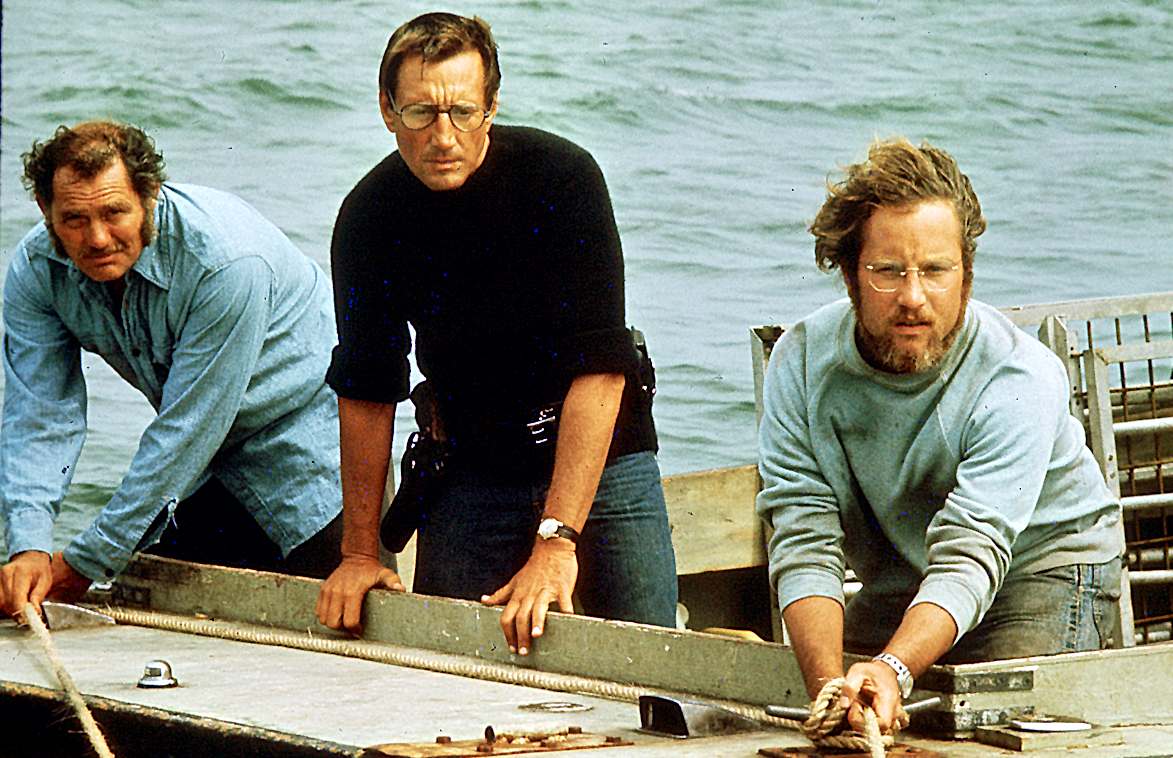
FILMING
Principal photography began May 2, 1974, on the island of Martha's Vineyard, Massachusetts, selected after consideration was given to eastern Long Island. Brown explained later that the production "needed a vacation area that was lower middle class enough so that an appearance of a
shark would destroy the tourist business." Martha's Vineyard was also chosen because the surrounding ocean had a sandy bottom that never dropped below 35 feet (11 m) for 12 miles (19 km) out from shore, which allowed the mechanical sharks to operate while also beyond sight of land. As Spielberg wanted to film the aquatic sequences relatively close-up to resemble what people see while swimming, cinematographer Bill Butler devised new equipment to facilitate marine and underwater shooting, including a rig to keep the camera stable regardless of tide and a sealed submersible camera box. Spielberg asked the art department to avoid red in both scenery and wardrobe, so that the blood from the attacks would be the only red element and cause a bigger shock.
Initially the film's producers wanted to train a great white shark but quickly realized this wasn't possible so three full-size pneumatically powered prop sharks
- which the film crew nicknamed "Bruce" after Spielberg's lawyer, Bruce Ramer
- were made for the production: a "sea-sled shark", a full-body prop with its belly missing that was towed with a 300-foot (91 m) line, and two "platform sharks", one that moved from camera-left to -right (with its hidden left side exposing an array of pneumatic hoses), and an opposite model with its right flank uncovered. The sharks were designed by art director Joe Alves during the third quarter of 1973. Between November 1973 and April 1974, the sharks were fabricated at Rolly Harper's Motion Picture & Equipment Rental in Sun Valley, California. Their construction involved a team of as many as 40 effects technicians, supervised by mechanical effects supervisor Bob Mattey, best known for creating the giant squid in
20,000 Leagues Under the
Sea. After the sharks were completed, they were trucked to the shooting location. In early July, the platform used to tow the two side-view sharks capsized as it was being lowered to the ocean floor, forcing a team of divers to retrieve it. The model required 14 operators to control all of the moving parts.
Jaws was the first major motion picture to be shot on the ocean, resulting in a troubled shoot, and went far over budget. David Brown said that the budget "was $4 million and the picture wound up costing $9 million"; the effects outlays alone grew to $3 million due to the problems with the mechanical sharks. Disgruntled crew members gave the film the nickname "Flaws". Spielberg attributed many problems to his perfectionism and his inexperience. The former was epitomized by his insistence on shooting at sea with a life-sized shark; "I could have shot the movie in the tank or even in a protected lake somewhere, but it would not have looked the same," he said. As for his lack of experience: "I was naive about the ocean, basically. I was pretty naive about mother nature and the hubris of a filmmaker who thinks he can conquer the elements was foolhardy, but I was too young to know I was being foolhardy when I demanded that we shoot the film in the
Atlantic Ocean and not in a North Hollywood tank." Gottlieb said that "there was nothing to do except make the movie", so everyone kept overworking, and while as a writer he did not have to attend the ocean set every day, once the crewmen returned they arrived "ravaged and sunburnt, windblown and covered with salt water".
Shooting at sea led to many delays: unwanted sailboats drifted into frame, cameras got soaked, and the Orca once began to sink with the actors on board. The prop sharks frequently malfunctioned owing to a series of problems including bad weather, pneumatic hoses taking on salt water, frames fracturing due to
water resistance, corroding skin, and electrolysis. From the first water test onward, the "non-absorbent" neoprene foam that made up the sharks' skin soaked up liquid, causing the sharks to balloon, and the sea-sled model frequently got entangled among forests of seaweed. Spielberg later calculated that during the 12-hour daily work schedule, on average only four hours were actually spent filming. Gottlieb was nearly decapitated by the boat's propellers, and Dreyfuss was almost imprisoned in the steel cage. The actors were frequently seasick. Shaw also fled to Canada whenever he could due to tax problems, engaged in binge drinking, and developed a grudge against
Dreyfuss, who was getting rave reviews for his performance in Duddy Kravitz. Editor Verna Fields rarely had material to work with during principal photography, as according to Spielberg "we would shoot five scenes in a good day, three in an average day, and none in a bad day."
The delays proved beneficial in some regards. The script was refined during production, and the unreliable mechanical sharks forced Spielberg to shoot many scenes so that the shark was only hinted at. For example, for much of the shark hunt, its location is indicated by the floating yellow barrels. The opening had the shark devouring Chrissie, but it was rewritten so that it would be shot with Backlinie being dragged and yanked by cables to simulate an attack. Spielberg also included multiple shots of just the dorsal fin. This forced restraint is widely thought to have added to the film's suspense. As Spielberg put it years later, "The film went from a Japanese Saturday matinee horror flick to more of a Hitchcock, the less-you-see-the-more-you-get thriller." In another interview, he similarly declared, "The shark not working was a godsend. It made me become more like Alfred Hitchcock than like Ray Harryhausen." The acting became crucial for making audiences believe in such a big shark: "The more fake the shark looked in the water, the more my anxiety told me to heighten the naturalism of the performances."
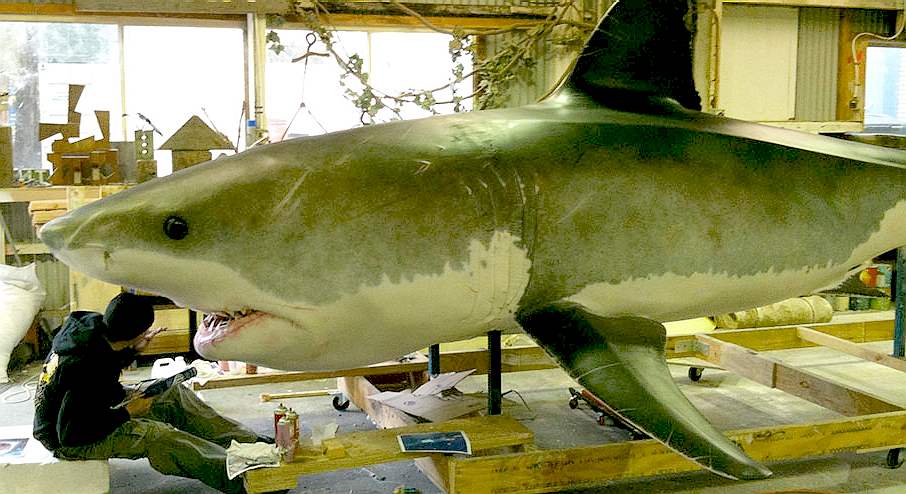
Footage of real sharks was shot by Ron and Valerie Taylor in the waters off Dangerous Reef in South Australia, with a short actor in a miniature shark cage to create the illusion that the sharks were enormous. During the Taylors' shoot, a great white attacked the boat and cage. The footage of the cage attack was so stunning that Spielberg was eager to incorporate it in the film. No one had been in the cage at the time and the script, following the novel, originally had the shark killing Hooper in it. The storyline was consequently altered to have Hooper escape from the cage, which allowed the footage to be used. As production executive Bill Gilmore put it, "The shark down in Australia rewrote the script and saved Dreyfuss's character."
Although principal photography was scheduled to take 55 days, it did not wrap until October 6, 1974, after 159 days. Spielberg, reflecting on the protracted shoot, stated, "I thought my career as a filmmaker was over. I heard rumors ... that I would never work again because no one had ever taken a film 100 days over schedule." Spielberg himself was not present for the shooting of the final scene in which the shark explodes, as he believed that the crew were planning to throw him in the water when the scene was done. It has since become a tradition for Spielberg to be absent when the final scene of one of his films is being shot. Afterward, underwater scenes were shot at the Metro-Goldwyn-Mayer water tank in Culver City, with stuntmen Dick Warlock and Frank James Sparks as stand-ins for Dreyfuss in the scene where the
shark attacks the cage, as well as near Santa Catalina Island, California. Fields, who had completed a rough cut of the first two-thirds of the film, up until the shark hunt, finished the editing and reworked some of the material. According to Zanuck, "She actually came in and reconstructed some scenes that Steven had constructed for comedy and made them terrifying, and some scenes he shot to be terrifying and made them comedy scenes." The boat used for the Orca was brought to Los Angeles so the sound effects team could record sounds for both the ship and the underwater scenes.
Two scenes were altered following test screenings. As the audience's screams had covered up Scheider's "bigger boat" one-liner, Brody's reaction after the shark jumps behind him was extended, and the volume of the line was raised. Spielberg also decided that he was greedy for "one more scream", and
re-shot the scene in which Hooper discovers Ben Gardner's body, using $3,000 of his own money after Universal refused to pay for the
re-shoot. The underwater scene was shot in Fields's swimming pool in Encino, California, using a
life-cast latex model of Craig Kingsbury's head attached to a fake body, which was placed in the wrecked boat's hull. To simulate the murky waters of Martha's Vineyard, powdered milk was poured into the pool, which was then covered with a tarpaulin.
MARKETING
Universal spent $1.8 million marketing Jaws, including an unprecedented $700,000 on national television spot advertising. The media blitz included about two dozen 30-second advertisements airing each night on prime-time network TV between June 18, 1975, and the film's opening two days later. Beyond that, in the description of film industry scholar Searle Kochberg, Universal "devised and co-ordinated a highly innovative plan" for the picture's marketing. As early as October 1974, Zanuck, Brown, and Benchley hit the television and radio talk show circuit to promote the paperback edition of the novel and the forthcoming film.
The studio and publisher Bantam agreed on a title logo that would appear on both the paperback and in all of the advertising for the film. The centerpieces of the joint marketing strategy were John Williams's theme and the poster image featuring the shark approaching a lone female swimmer. The poster was based on the paperback's cover, and had the same artist, Bantam employee Roger Kastel. The Seiniger Advertising agency spent six months designing the poster; principal Tony Seiniger explained that "no matter what we did, it didn't look scary enough". Seiniger ultimately decided that "you had to actually go underneath the shark so you could see his teeth."
More merchandise was created to take advantage of the film's release. In 1999, Graeme Turner wrote that Jaws was accompanied by what was "probably the most elaborate array of tie-ins" including "a sound-track album, T-shirts, plastic tumblers, a book about the making of the movie, the book the movie was based on, beach towels, blankets, shark costumes, toy sharks, hobby kits, iron-on transfers, games, posters, shark's tooth necklaces, sleepwear, water pistols, and more." The Ideal Toy Company, for instance, produced a game in which the player had to use a hook to fish out items from the shark's mouth before the jaws closed.
RELEASE STRATEGY
The glowing audience response to a rough cut of the film at two test screenings in Dallas on March 26, 1975, and one in Long Beach, on March 28, along with the success of Benchley's novel and the early stages of Universal's marketing campaign, generated great interest among theater owners, facilitating the studio's plan to debut Jaws at hundreds of cinemas simultaneously. A third and final preview screening, of a cut incorporating changes inspired by the previous presentations, was held in Hollywood on April 24. After Universal chairman Lew Wasserman attended one of the screenings, he ordered the film's initial release — planned for a massive total of as many as 900 theaters — to be cut down, declaring, "I want this picture to run all summer long. I don't want people in Palm Springs to see the picture in Palm Springs. I want them to have to get in their cars and drive to see it in Hollywood." Nonetheless, the several hundred theaters that were still booked for the opening represented what was then an unusually wide release.
At the time, wide openings were associated with movies of doubtful quality; not uncommon on the grindhouse and exploitation side of the industry, they were customarily employed to diminish the effect of negative reviews and word of mouth. There had been some recent exceptions, including the rerelease of Billy Jack and the original release of its sequel The Trial of Billy Jack, the Dirty Harry sequel Magnum Force, and the latest installments in the James Bond series. Still, the typical major studio film release at the time involved opening at a few big-city theaters, which allowed for a series of premieres. Distributors would then slowly forward prints to additional locales across the country, capitalizing on any positive critical or audience response. The outsized success of The Godfather in 1972 had sparked a trend toward wider releases, but even that film had debuted in just five theaters, before going wide in its second weekend.
On June 20, Jaws opened across North America on 464 screens — 409 in the United States, the remainder in Canada. The coupling of this broad distribution pattern with the movie's then even rarer national television marketing campaign yielded a release method virtually unheard-of at the time. (A month earlier, Columbia Pictures had done something similar with a Charles Bronson thriller, Breakout, though that film's prospects for an extended run were much slimmer.) Universal president Sid Sheinberg reasoned that nationwide marketing costs would be amortized at a more favorable rate per print relative to a slow, scaled release. Building on the film's success, the release was subsequently expanded on July 25 to nearly 700 theaters, and on August 15 to more than 950. Overseas distribution followed the same pattern, with intensive television campaigns and wide releases — in Great Britain, for instance, Jaws opened in December at more than 100 theaters.
For its 40th anniversary, the film was released in selected theaters (across approximately 500 theaters) in the United States on Sunday, June 21, and Wednesday, June 24, 2015.
|
